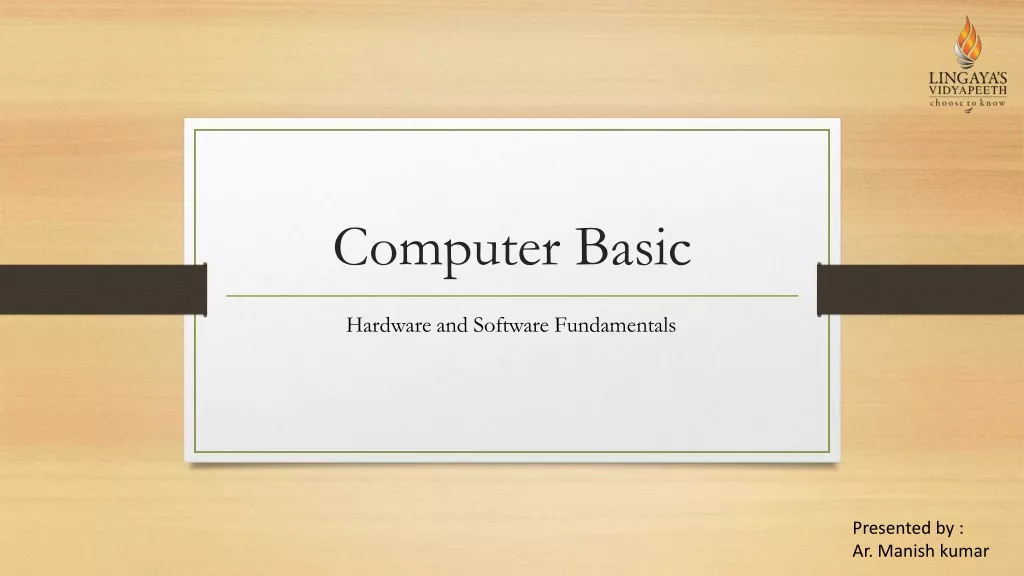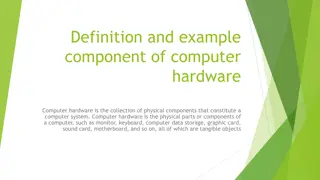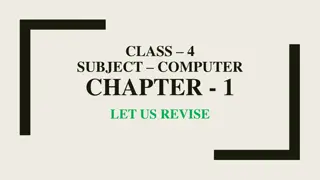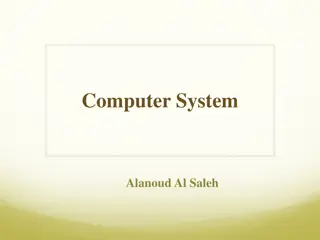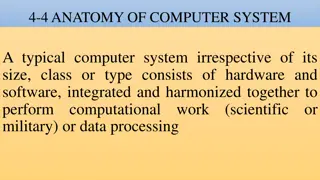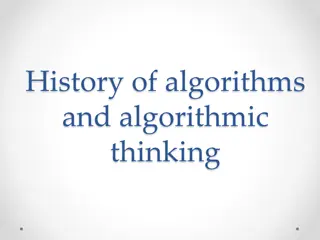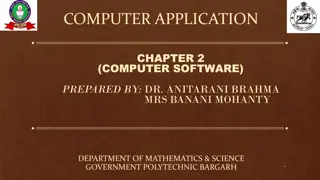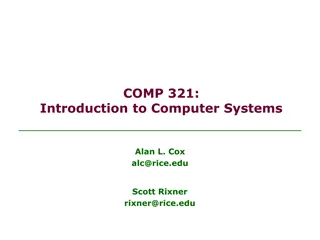Computer Hardware and Software
This content delves into essential concepts like hardware components (CPU, memory), software types (operating systems, applications), memory measurement, programming languages, algorithms, variables, and their usage. Gain insights into the fundamental aspects of computers and programming through detailed explanations and visual aids.
Download Presentation

Please find below an Image/Link to download the presentation.
The content on the website is provided AS IS for your information and personal use only. It may not be sold, licensed, or shared on other websites without obtaining consent from the author.If you encounter any issues during the download, it is possible that the publisher has removed the file from their server.
You are allowed to download the files provided on this website for personal or commercial use, subject to the condition that they are used lawfully. All files are the property of their respective owners.
The content on the website is provided AS IS for your information and personal use only. It may not be sold, licensed, or shared on other websites without obtaining consent from the author.
E N D
Presentation Transcript
COMP 110-001 Mid-Term Review Yi Hong May 27, 2015
Announcement Midterm on Friday, May 29 Closed books, no notes, no computer
Today A whirlwind tour of almost everything we have covered so far You should start preparing for mid-term if you haven t Finish the mid-term practice before Thursday Review slides and textbook Review your lab / assignment code
Hardware vs. Software Hardware - physical machine CPU, Memory Software - programs that give instructions to the computer Windows XP, Games, Eclipse 4
Hardware CPU the brain of your computer Memory stores data for the computer How much the brain can remember Main memory: RAM Auxiliary memory: Hard Drive 5
Memory Measured in bytes 1 byte = 8 bits Bit is either 0 or 1 Language of the computer is in bits 6
Programming Languages High-level language (human readable) Your Program Compiler Low-level language (computer readable) Machine Language (Bits) 7
Algorithms and Pseudocode Algorithm a set of instructions for solving a problem Pseudocode combination of code and English used to express an algorithm before before writing algorithm into code We can also use flow-chat to write pseudocode 8
Variables Used to store data in a program The data currently in a variable is its value Name of variable is an identifier Letters, digits, underscore Letters, digits, underscore Cannot start with digits Can change value throughout program Choose variable names that are meaningful! value identifier 9
How to Use Variables Declare Declare a variable int number; Assign Assign a value to the variable number = 37; Change Change the value of the variable number = 513; 10
Keywords Reserved words with predefined meanings You cannot name your variables keywords if, else, return, new 11
Data Type What kind of value the variable can hold Two kinds of types. Primitive type - indecomposable values Names begin with lowercase letters int, double, char, float, byte, boolean, and others Class type - objects with both data and methods Names by convention begin with uppercase letter Scanner, String, Student 12
Assignment Statements Change a variable s value Syntax variable = expression; Example sleepNeeded = 8; sleepDesired = sleepNeeded * 2; 13
Assignment Compatibilities int x = 5; byte short int Long float double double y = 12.7; y = x; = OK x = y; = Not OK 14
Type Casting x = (int) y; = (int) OK 15
Arithmetic Operators Unary operators +, -, ++, --, ! Binary arithmetic operators *, /, %, +, - rate*rate + delta 1/(time + 3*mass) (a - 7)/(t + 9*v) 16
Modular Arithmetic: % Remainder 7 % 3 = 1 (7 / 3 = 2, remainder 1) 8 % 3 = 2 (8 / 3 = 2, remainder 2) 9 % 3 = 0 (9 / 3 = 3, remainder 0) 17
Parentheses and Precedence Expressions inside parentheses evaluated first (cost + tax) * discount cost + (tax * discount) Precedence rules Highest Precedence First: the unary operators +, -, !, ++, and -- Second: the binary arithmetic operators *, /, % Third: the binary arithmetic operators + and Lowest Precedence 18
Errors Syntax error grammatical mistake in your program Java will not compile programs with syntax error Run-time error an error that is detected during program execution E.g., exceptions during execution Logic error a mistake in a program caused by the underlying algorithm 19
Strings A string (lowercase) is a sequence of characters Hello world! Enter a whole number from 1 to 99. String (capital S) is a class in Java, not a primitive type 20
String String animal = aardvark ; System.out.println(animal); aardvark 21
String Concatenation String animal = aardvark ; String sentence; sentence = My favorite animal is the + animal; My favorite animal is the aardvark 22
Strings Methods myString.length(); myString.equals( a string ); myString.toLowerCase(); MyString.indexOf( ); myString.trim(); For other methods, check Java API 23
String Indices U 0 N 1 C 2 i s 5 G 7 r 8 e 9 10 11 a t 3 4 6 String output = myString.substring(1, 8); 24
String Indices U 0 N 1 C 2 i s 5 G 7 r 8 e 9 10 11 a t 3 4 6 String output = myString.substring(1, 8); 25
Escape Characters \ \ \\ \n \r \t Double quote Single quote Backslash New line Carriage return Tab 26
Keyboard Input Scanner keyboard = new Scanner(System.in); int num = keyboard.nextInt(); 27
Comments // this is a comment /* This is also a comment. it ends here --->*/ 28
Boolean Expressions An expression that is either true or false Examples: It is sunny today (true) 10 is larger than 5 (true) Today is Saturday (false) 29
if/else Statements import java.util.*; Prompt user for integer public class FlowChart { public static void main(String[] args) { System.out.println("Give me an integer:"); Scanner keyboard = new Scanner(System.in); int inputInt = keyboard.nextInt(); if (inputInt > 10) { System.out.println("big number"); } else { System.out.println("small number"); } } } Is input greater than 10? No Yes Print: big number Print: small number 30
If-else-if for Multi-Branch Selections if ( case1 ) { if (year==1) { System.out.println( Freshman ); // branch 1 } else if (year==2) { System.out.println( Sophomore ); } else if ( case2) { // branch 2 } else if (year==3) { System.out.println( Junior ); } else if ( case3 ) { } else { } } else { System.out.println( Senior ); }
Java Comparison Operators for Primitive Values Equal to Not equal to Greater than Greater than or equal to == != > >= Example expressions: variable <= 6 myInt > 5 5 == 3 Less than Less than or equal to < <= The result is a boolean value (true/false) 32
Boolean Type Can be either true or false boolean sunny = true; boolean cloudy = false; if (sunny || cloudy) { // walk to school } 33
&&, || operators AND if ((temperature > 50) && (temperature < 75)) { // walk to school } OR if (sunny || cloudy) { // walk to school } 34
The ! (NOT) operator !true is false !false is true Example: walk to school if it is NOT cloudy if (!cloudy) { // walk to school } 35
Loops Loop: part of a program that repeats Start Body: statements being repeated Enough sandwiches? Yes Iteration: each repetition of body Make sandwich No Distribute sandwiches Stopping condition 36
Types of Loops while Safest choice Not always the best do-while Loop iterates AT LEAST once for Similar to while, but often more convenient syntax Most useful when you have a known number of iterations you need to do 37
Using a while Loop n=1 int n = 1; while (n <= 10) n <= 10? Yes { No System.out.println(n); Output n n = n + 1; End } n=n+1 38
Using a for Loop int n; for (n = 1; n <= 10; n++) { System.out.println(n); } 39
Infinite Loop Example int n; for (n = 1; n <= 10; n = 0) { System.out.println(n); } 40
The break statement for (int item = 1; item <= 5; item++) { System.out.print( Enter cost of item # + item + : $ ); amount = keyboard.nextDouble(); total = total + amount; if (total >= 100) { System.out.println( You spent all your money. ); break; } System.out.println( Your total so far is $ + total); } System.out.println( You spent $ + total); 41
Ending a Loop Count-controlled loops If you know the number of loop iterations for (count = 0; count < iterations; count++) User-controlled loops Change the value of control variable E.g., Ask-before-iterating, or sentinel value ( if user input is smaller than 0) E.g., booleans, matching is found 42
Nested Loops Example for (int i = 1; i<10; i++) { for (int j = 1; j<=i i; j++) { System.out.print( i + * + j + = + (i * j) + \t ); } System.out.println(); } Inner loop Outer loop 43
Classes, Objects, and Methods Class: a definition of a kind of object Object: an instance of a class Contains instance variables (data) and methods Methods Methods that return a value Methods that return nothing 44
Class A class is the definition of a kind of object A blueprint for constructing specific objects 45
Objects, Instantiation Object Name: patsCar amount of fuel: 10 gallons speed: 55 miles per hour license plate: 135 XJK Object Name: ronsCar Object Name: suesCar amount of fuel: 2 gallons speed: 75 miles per hour license plate: 351 WLF amount of fuel: 14 gallons speed: 0 miles per hour license plate: SUES CAR Instantiations, or instances, of the class Automobile
Creating an Object Create an object jack of class Student Student jack = new Student(); Assign memory address of object to variable Return memory address of object Create an object Scanner keyboard = new Scanner(System.in); Create an object keyboard of class Scanner
Instance Variables Data defined in the class are called instance variables public String name; public int classYear; public double gpa; public String major; variables public: no restrictions on how these instance variables are used (more details later public is actually a bad idea here) Data type: int, double, String
Methods Two kinds of methods Methods that return a value Examples: String s substring() method, String s indexOf() method, etc. Methods that return nothing Perform some action other than returning an item Example: System.out.println() 49
Methods returns a String public String getMajor() { return major; } return type public void increaseYear() { classYear++; } returns nothing 50


